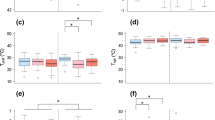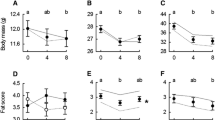Abstract
In nature, many organisms alter their developmental trajectory in response to environmental variation. However, studies of thermal acclimation have historically involved stable, unrealistic thermal treatments. In our study, we incorporated ecologically relevant treatments to examine the effects of environmental stochasticity on the thermal acclimation of the fall field cricket (Gryllus pennsylvanicus). We raised crickets for 5 weeks at either a constant temperature (25°C) or at one of three thermal regimes mimicking a seasonal decline in temperature (from 25 to 12°C). The latter three treatments differed in their level of thermal stochasticity: crickets experienced either no diel cycle, a predictable diel cycle, or an unpredictable diel cycle. Following these treatments, we measured several traits considered relevant to survival or reproduction, including growth rate, jumping velocity, feeding rate, metabolic rate, and cold tolerance. Contrary to our predictions, the acclimatory responses of crickets were unrelated to the magnitude or type of thermal variation. Furthermore, acclimation of performance was not ubiquitous among traits. We recommend additional studies of acclimation in fluctuating environments to assess the generality of these findings.






Similar content being viewed by others
References
Alexander RD (1968) Life cycle origins, speciation, and related phenomena in crickets. Q Rev Biol 43:1–41
Alexander RD, Meral GH (1967) Seasonal and daily chirping cycles in the northern spring and fall field crickets, Gryllus veletis and G. pennsylvanicus. Ohio J Sci 67:200–209
Angilletta MJ (2009) Thermal adaptation: a theoretical and empirical synthesis. Oxford University Press, Oxford
Angilletta MJ, Winters RS, Dunham AE (2000) Thermal effects on the energetics of lizard embryos: implications for hatchling phenotypes. Ecology 81:2957–2968
Angilletta MJ, Bennett AF, Guderley H, Navas CA, Seebacher F, Wilson RS (2006) Coadaptation: a unifying principle in evolutionary thermal biology. Physiol Biochem Zool 79:282–294
Angilletta MJ, Wilson RS, Niehaus AC, Sears MW, Navas CA, Ribeiro PL (2007) Urban physiology: city ants possess high heat tolerance. PLoS ONE 2:e258
Beddow TA, Johnston IA (1995) Plasticity of muscle contractile properties following temperature acclimation in the marine fish Myoxocephalus scorpius. J Exp Biol 198:193–201
Birchard GF, Reiber CL (1995) Growth, metabolism and chorioallantoic vascular density of developing snapping turtles (Chelydra serpentine)—influence of temperature. Physiol Zool 68:799–811
Booth DT (1998) Nest temperature and respiratory gases during natural incubation in the broad-shelled river turtle, Chelodina expansa (Testudinae: Chelidae). Aust J Zool 46:183–191
Brakefield PM, Kesbeke F (1997) Genotype–environment interactions for insect growth in constant and fluctuating temperature regimes. Proc Royal Soc Lond Ser B Biol Sci 264:717–723
Carriere Y, Simons AM, Roff DA (1996) The effect of the timing of post-diapause egg development on survival, growth, and body size in Gryllus pennsylvanicus. Oikos 75:463–470
Condon CHL, Wilson RS (2006) Effect of thermal acclimation on female resistance to forced matings in the eastern mosquito fish. Anim Behav 72:585–593
Condon CHL, Chenoweth SF, Wilson RS (2010) Zebrafish take their cue from temperature but not photoperiod for the seasonal plasticity of thermal performance. J Exp Biol 213:3705–3709
De Marco P, Resende DC (2002) Activity patterns and thermoregulation in a tropical dragonfly assemblage. Odonatologica 31:129–138
Deere JA, Chown SL (2006) Testing the beneficial acclimation hypothesis and its alternatives for locomotor performance. Am Nat 168:630–644
DeWitt TJ, Scheiner SM (2004) Phenotypic plasticity: Functional and conceptual approaches. Oxford University Press, Oxford, UK
Du W-G, Ji X (2003) The effects of incubation thermal environments on size, locomotor performance and early growth of hatchling soft-shelled turtles, Pelodiscus sinensis. J Therm Biol 28:279–286
Folguera G, Bastias DA, Caers J, Rojas JM, Piulachs MD, Belles X, Bozinovic F (2011) An experimental test of the role of environmental temperature variability on ectotherm molecular, physiological and life-history traits: implications for global warming. Comp Biochem Physiol A 159:242–246
French BW, Cade WH (1987) The timing of calling, movement, and mating in the field crickets Gryllus veletis, G. pennsylcanicus, and G. integer. Behav Ecol Sociobiol 21:157–162
Fry FEJ, Hart JS (1948) Cruising speed of goldfish in relation to water temperature. J Fish Res Board Can 7:169–175
Gabriel W (2005) How stress selects for reversible phenotypic plasticity. J Evol Biol 18:873–883
Gabriel W, Lynch M (1992) The selective advantage of reaction norms for environmental tolerance. J Evol Biol 5:41–59
Gabriel W, Luttbeg B, Sih A, Tollrian R (2005) Environmental tolerance, heterogeneity, and the evolution of reversible plastic responses. Am Nat 166:339–353
Georges A, Beggs K, Young JE, Doody JS (2005) Modelling development of reptile embryos under fluctuating temperature regimes. Physiol Biochem Zool 78:18–30
Gibert P, Huey RB (2001) Chill-coma temperature in Drosophila: effects of developmental temperature, latitude, and phylogeny. Physiol Biochem Zool 74:429–434
Gilchrist GW (1996) A quantitative genetic analysis of thermal sensitivity in the locomotor performance curve of Aphidius ervi. Evolution 50:1560–1572
Glanville EJ, Seebacher F (2006) Compensation for environmental change by complementary shifts of thermal sensitivity and thermoregulatory behaviour in an ectotherm. J Exp Biol 209:4869–4877
Hoback WW, Wagner WE (1997) The energetic cost of calling in the variable field cricket, Gryllus lineaticeps. Physiol Entomol 22:286–290
Hokanson KEF, Kleiner CF, Thorslund TW (1977) Effects of constant temperatures and diel temperature fluctuations on specific growth and mortality rates and yield of juvenile rainbow trout, Salmo gairdneri. J Fish Res Board Canada 34:639–648
Huey RB, Berrigan D (1996) Temperature, demography, and ectotherm fitness. Am Nat 158:204–210
Husak JF (2006) Does speed help you survive? A test with collared lizards of different ages. Funct Ecol 20:174–179
Johnson TP, Bennett AF (1995) The thermal acclimation of burst escape performance in fish: an integrated study of molecular and cellular physiology and organismal performance. J Exp Biol 198:2165–2175
Johnston IA, Temple GK (2002) Thermal plasticity of skeletal muscle phenotype in ectothermic vertebrates and its significance for locomotory behaviour. J Exp Biol 205:2305–2322
Levins R (1968) Evolution in changing environments: some theoretical explorations. Princeton University Press, New Jersey
Marsh RL, Bennett AF (1986) Thermal dependence of sprint performance of the lizard Sceloporus occidentalis. J Exp Biol 126:79–87
Martin N, Kraffe E, Guderley H (2009) Effects of day length on oxidative capacities of mitochondria from red muscle of rainbow trout (Oncorhynchus mykiss). Comp Biochem Physiol A 152:599–603
McMahon RF, Russell-Hunter WD, Aldridge DW (1995) Lack of metabolic temperature compensation in the intertidal gastropod Littorina saxatilis (Olivi) and L. obtusata. Hydrobiologia 309:89–100
Miles DB (2004) The race goes to the swift: fitness consequences of variation in sprint performance of juvenile lizards. Evol Ecol Res 6:63–75
Moran NA (1992) The evolution and maintenance of alternative phenotypes. Am Nat 139:971–989
Niehaus AC, Wilson RS, Franklin CE (2006) Short- and long-term consequences of thermal variation in the larval environment of anurans. J Anim Ecol 75:686–692
Niehaus AC, Wilson RS, Seebacher F, Franklin CE (2011) Striped marsh frog (Limnodynastes peronii) tadpoles do not acclimate metabolic performance to thermal variability. J Exp Biol 214:1965–1970
Prosser CL (1991) Comparative animal physiology. Saunders, Philadelphia
Randall D, Burggren W, French K (2002) Animal Physiology, 5th edn. W.H. Freeman and Company, New York
Sanford E (2002) The feeding, growth, and energetics of two rocky intertidal predators (Pisaster ochraceus and Nucella canaliculata) under water temperatures simulating episodic upwelling. J Exp Marine Bio Ecol 273:199–218
Schaefer J, Ryan A (2006) Developmental plasticity in the thermal tolerance of zebrafish Danio rerio. J Fish Biol 69:722–734
Schuler MS, Cooper BS, Storm JJ, Sears MW, Angilletta MS (2011) Isopods failed to acclimate their thermal sensitivity of locomotor performance during predictable or stochastic cooling. Plos One 6:e20905
Seebacher F, Wilson RS (2006) Fighting fit: Thermal plasticity of metabolic function and fighting success in the crayfish Cherax destructor. Funct Ecol 20:1045–1053
Seebacher F, Guderley H, Elsey R, Trosclair PL (2003) Seasonal acclimatisation of muscle metabolic enzymes in a reptile (Alligator mississippiensis). J Exp Biol 126:1193–1200
Shih HT, Mok HK (2000) ETHOM: event-recording computer software for the study of animal behavior. Acta Zool Taiwanica 11:47–61
Siddiqui WH, Barlow CA (1972) Population growth of Drosophila melanogaster at constant and alternating temperatures. Ann Entomol Soc Am 65:993–1001
Swank DM, Rome LC (2001) The influence of thermal acclimation on power production during swimming II. Mechanics of scup red muscle under in vivo conditions. J Exp Biol 204:419–430
Temple GK, Johnston IA (1998) Testing hypotheses concerning the phenotypic plasticity of escape performance in fish of the family Cottidae. J Exp Biol 201:317–331
Terblanche JS, Nyamukondiwa C, Kleynhans E (2010) Thermal variability alters climatic stress resistance and plastic responses in a globally invasive pest, the Mediterranean fruit fly (Ceratitis capitata). Entomol Exp Appl 137:304–315
Wilson RS, Franklin CE (1999) Thermal acclimation of locomotor performance in tadpoles of the frog Limnodynastes peronii. J Comp Physiol B 169:445–451
Wilson RS, Franklin CE (2002) Testing the beneficial acclimation hypothesis. Trends Ecol Evol 17:66–70
Wilson RS, Hammill E, Johnston IA (2007) Competition moderates the benefits of thermal acclimation to reproductive performance in male eastern mosquitofish. Proc Royal Soc Lond B 274:1199–1204
Acknowledgments
ACN and RSW were supported by travel grants from the University of Queensland.
Author information
Authors and Affiliations
Corresponding author
Additional information
Communicated by I.D. Hume.
Rights and permissions
About this article
Cite this article
Niehaus, A.C., Wilson, R.S., Storm, J.J. et al. Fall field crickets did not acclimate to simulated seasonal changes in temperature. J Comp Physiol B 182, 199–207 (2012). https://doi.org/10.1007/s00360-011-0611-1
Received:
Revised:
Accepted:
Published:
Issue Date:
DOI: https://doi.org/10.1007/s00360-011-0611-1




